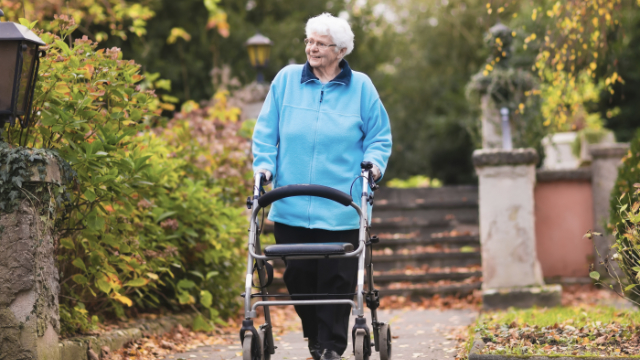
If youâre over the age of 75, you might worry about the possibility of falling on a regular basis. This concern is completely understandable, as falls are the leading cause of injury for older adults, and the likelihood of falling increases with each additional year of age. About 40% of older adults living at home experience a fall once per year, and this figure is even higher for adults living in nursing homes and assisted living facilities.
One commonly recommended strategy to mitigate the risk of falling is for older adults to use a walking aid like a cane or frontâwheeled walker. These devices assist with upright balance and mobility, which are essential for avoiding a fall; however, some research has suggested that surprisingly, using a walking aid may be an independent risk factor for falling. This is likely due to lack of guidance on how to use these devices, as one study found that over 80% of wheeled frame users reported not receiving any instructions on how to use it and another found that 66% of patients with hip problems were not educated on which hand to hold their assistive device in.
In response, a 2020 study was conducted to investigate older adultsâ use of walking aids, how their usage patterns affect stability, and what the general perception is of walking aids from the perspective of users and healthcare professionals.
17 older adults are closely monitored while using a walking aid
For the study, researchers identified 17 older adults with an average age of 70 that regularly used a walking aid. These participants then completed the Falls Efficacy Scaleâwhich measures concerns about fallingâand were evaluated in different environments several outcome measures. They were also recorded on video while using a frontâwheeled walker to assess their techniques. Finally, two focus groups were formed, with one comprised of 5 walking aid users and the other comprised of 10 healthcare professionals. These focus groups were intended to stimulate meaningful discourse about the use of walking aids and identify any areas that could be improved.
Results showed that the percentage of time in which the walking aid was used incorrectly varied between participants, but all participants displayed incorrect usage at some point in the study. On average, the group had incorrect usage of walking aids during 16% of their single support periods and 30% of dual support periods. Video analysis also showed that many participants did not use frontâwheeled walkers properly. The most common error was lifting the frame when turning, which is risky and can lead to a fall.
The walking aid user focus group identified several key themes, one of which was that participants considered the lack of guidance in the safe use of walking aids to be a problem. Members of the healthcare provider focus group agreed that a goldâstandard, universally accepted approach was lacking for the prescription of walking aids and training of users, which highlights a gap that needs to be addressed. Healthcare providers reported that they instead rely on their clinical judgement regarding the userâs safety and gait performance, and that they train patients on how to use a walking aid based on practice and repetition rather than established guidelines.
Overall, results suggested that adherence to current guidance on how to safely use a walking aid in the home is poor amongst users, and that both environmental and designârelated factors serve as barriers to adherence. Participants also displayed low stability during incorrect use of walking aids, which indicates that they are putting themselves at risk of falling when improperly using these devices in various environments.
Key tips to ensure safe use of walking aids
These findings highlight the importance of proper use of walking aids and the need for better training of walking aid users. To accomplish this, experts must work together to establish clearer guidelines for healthcare providers who train patients to use walking aids, but in the meantime, here are a few key tips to help ensure youâre using a frontâwheeled walker (a popular type of walking aid) properly:
- The height of the walker should be adjusted so that your arms are slightly bent (about 20â30 degrees) when using it
- When using a frontâwheel walker, be sure to keep the front of your body in line with the back two posts of the walker
- Advance the walker a few inches in front of you first, and make sure all tips and wheels are touching the ground before taking a step
- When youâre ready to take a step, step forward with your bad leg first, followed by your good leg, placing it in front of your lead foot
- When turning the walker, keep the walker in front of you and take small steps; DO NOT pick the walker up at any time
- Donât place all your weight on the walker; allow it to assist your gait by bearing only part of your weight upon it
- Add tennis balls to the bottom of the walker to make it glide more smoothly
If you or someone you care for uses a walking aid, we can provide additional guidance on how to properly use these devices to reduce the risk for falling. Contact us for more information.
